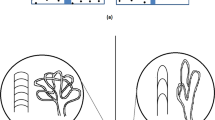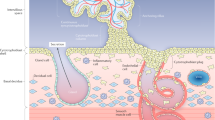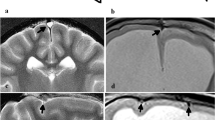Abstract
THE currently accepted theory of maternal blood flow through the intervillous space of the primate placenta1 is that maternal blood entering through basally situated spiral arterioles spurts up towards the chorionic plate under the influence of the vis a tergo of the maternal arterial pressure, spreads laterally and falls back to drain through basal venous openings. Short circuiting from artery to adjacent vein is believed to be avoided purely by virtue of the arterial pressure. This theory based on. cineangiographic evidence takes no account of the structure of the foetal portion of the placenta. The latter consists of numerous lobules or cotyledons of which the principal fifty to sixty are arranged in the form of hollow centred bush-like structures as seen in corrosion casts of the foetal vasculature2,3. Each lobule arises by a main chorionic stem, and is supplied through a major branch of an umbilical artery. Subsequent branches supply an extensive capillary network within the mass of terminal villi which crowd round the central intralobular space. This lobular pattern can be recognized in histological sections in the form of dense masses of villi orientated round cavities4. Interlobular and subchorial areas show greater separation between the villi.
This is a preview of subscription content, access via your institution
Access options
Subscribe to this journal
Receive 51 print issues and online access
$199.00 per year
only $3.90 per issue
Buy this article
- Purchase on Springer Link
- Instant access to full article PDF
Prices may be subject to local taxes which are calculated during checkout
Similar content being viewed by others
References
Ramsey, E. M., Amer. J. Obstet. Gynec., 84, 1649 (1962).
Wilkin, P., in The Placenta and Fetal Membranes (edit. by Villee, C. A.), 154 (Williams and Wilkins, Baltimore, 1960).
Crawford, J. M., Amer. J. Obstet. Gynec., 84, 1543 (1962).
Gruenwald, P., Bull. Johns Hopkins Hosp., 119, 172 (1966).
Wigglesworth, J. S., thesis, Univ. Cambridge, 12 (1964).
Reynolds, S. R. M., Amer. J. Obstet. Gynec., 94, 425 (1966).
Freese, U. E., Amer. J. Obstet. Gynec., 94, 354 (1966).
Ramsey, E. M., Martin, C. B., and Donner, M. W., Amer. J. Obstet. Gynec., 98, 419 (1967).
Burchell, R. C., Amer. J. Obstet. Gynec., 98, 303 (1967).
Boyd, J. D., and Hamilton, W. J., J. Obstet. Gynaec. Brit. Cwlth., 74, 161 (1967).
Author information
Authors and Affiliations
Rights and permissions
About this article
Cite this article
WIGGLESWORTH, J. Vascular Organization of the Human Placenta. Nature 216, 1120–1121 (1967). https://doi.org/10.1038/2161120a0
Received:
Published:
Issue Date:
DOI: https://doi.org/10.1038/2161120a0
This article is cited by
-
Placental morphometry using a computer assisted measuring programme: reference values for normal pregnancies at term
Archives of Gynecology and Obstetrics (1991)
Comments
By submitting a comment you agree to abide by our Terms and Community Guidelines. If you find something abusive or that does not comply with our terms or guidelines please flag it as inappropriate.



